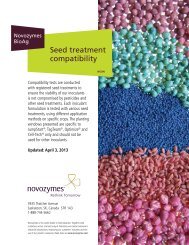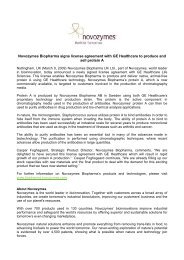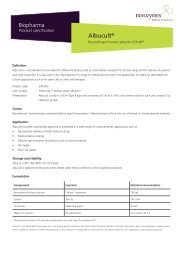SaVE tiME aNd MONEy witH cElluSOft - Improve - Novozymes
SaVE tiME aNd MONEy witH cElluSOft - Improve - Novozymes
SaVE tiME aNd MONEy witH cElluSOft - Improve - Novozymes
You also want an ePaper? Increase the reach of your titles
YUMPU automatically turns print PDFs into web optimized ePapers that Google loves.
t e x t i l e r e p r i n t<br />
Save time and money with<br />
The machines are running full-speed at PT. Kemilau Warna<br />
Ceria’s factory in Java, Indonesia. Producing textiles means using<br />
large amounts of water, electricity, and chemicals. <strong>Novozymes</strong>’<br />
Cellusoft Combi combines three processes into one, saving costs<br />
and production time without affecting the quality of the fabric.<br />
About 85% of the water in textile production<br />
is used predominantly for dyeing and finishing.<br />
These processes use about 75% of all the energy<br />
and 65% of the chemicals to convert fiber into<br />
textile. Any cut in production time, chemical,<br />
energy, and water usage means substantial cost<br />
savings for textile mills constantly working with<br />
tight cost margins. It also washes away much of<br />
the industry’s bad reputation as a great industrial<br />
polluter.<br />
So far enzymes have been helpful in this<br />
respect both during bleach clean-up and bioblasting.<br />
Mills traditionally bleach to obtain smashing<br />
colors in the dyeing process. The bleach is<br />
normally rinsed with reducing agents and large<br />
amounts of hot water. By adding a small amount<br />
of catalase in the bleach clean-up process hydrogen<br />
peroxide is catalyzed into oxygen and water,<br />
resulting in lower water usage and less wastewater<br />
pollution.<br />
To get smooth cotton textiles with vibrant colors,<br />
textile mills polish the fabrics, targeting the<br />
small protruding fiber ends that make the fabric<br />
look fuzzy and create pills. Polishing can be done<br />
by singeing with a gas flame. The less harsh alternative,<br />
bioblasting, uses cellulases to polish the<br />
yarn surface and prevent pilling.<br />
Get two for one<br />
To optimize the processes and offer an environmentally<br />
friendly alternative, <strong>Novozymes</strong> has<br />
developed a product that combines bleach cleanup<br />
and bioblasting into one. “Cellusoft Combi<br />
greatly reduces time, energy, and water consumption<br />
by combining bioblasting and bleach cleanup<br />
processes in the dyeing step. The product<br />
allows end user mills to free up production and<br />
improve throughput,” says Umar Riaz, Global<br />
Marketing Manager for textiles at <strong>Novozymes</strong>.<br />
At PT. Kemilau Warna Ceria, they have tried<br />
to bioblast with Cellusoft Combi. The 1,600<br />
employees produce 13,000 meters woven fabric<br />
and 20,000 kg knitted fabric a day for dyeing<br />
and printing. The company has recently made<br />
large investments to develop a high-quality knitted<br />
fabric and has already invested in several new<br />
machines to improve capacity. To boost production<br />
further the director of PT. Kemilau Warna<br />
Ceria, Hendro Prasetyo, decided to try out the<br />
ready-to-use Cellusoft Combi. The first test results<br />
were promising. “We find the product very good,<br />
both technically and concept-wise. Cellusoft<br />
Combi reduces processing time and saves costs<br />
on electricity, water, and steam,” says Hendro<br />
Savings on bioblasting with Cellusoft ® Combi<br />
18<br />
Total processing cost per batch in USD<br />
16<br />
14<br />
12<br />
10<br />
8<br />
6<br />
4<br />
Enzyme<br />
Water<br />
Labor<br />
Electricity<br />
Steam<br />
Effluent<br />
2<br />
0<br />
Traditional<br />
bioblasting<br />
Bioblasting with<br />
Cellusoft ® Combi<br />
Cellusoft ® Combi can save the mill energy, time, and<br />
resources compared to traditional bioblasting products.<br />
1 0
t e x t i l e r e p r i n t<br />
Cellusoft ® Combi<br />
Prasetyo. Experts in the company were equally<br />
positive about the results. “Cellusoft Combi<br />
removed hydrogen peroxide from the fabric very<br />
well, and the bioblasting was excellent,” says<br />
Sukardi, head of the dyeing department at PT.<br />
Kemilau Warna Ceria.<br />
Time is money<br />
So far one of the greatest hurdles for using<br />
enzymes is that it introduces an extra step in the<br />
production. “Mills currently doing bioblasting<br />
and bleach clean-up in two separate processes<br />
now have the opportunity to combine both steps<br />
during dyeing in an economical way. Due to the<br />
unique nature of Cellusoft Combi, it doesn’t<br />
interact with dyes and improves fabric quality,<br />
while saving the mill up to 100 minutes in processing<br />
time, plus water, labor, and energy costs,”<br />
says Umar Riaz.<br />
The great savings that Cellusoft Combi gives<br />
create great interest in a competitive market.<br />
“A majority of our customers who’ve tested the<br />
product have now replaced the traditional acid<br />
cellulases with unique Cellusoft Combi,” says Han<br />
Kuilderd, Customer Solutions Manager for textiles<br />
at <strong>Novozymes</strong>. “Companies that bioblast with<br />
Cellusoft Combi can produce a high-quality fabric<br />
at virtually the same cost as fabrics that aren’t<br />
bioblasted but still achieve the smoothness and<br />
softness that bioblasted fabrics are known for. It’s<br />
simply a win-win product.”<br />
We want smooth,<br />
soft, high-quality textiles<br />
for our everyday<br />
clothes. Bioblasting<br />
with Cellusoft ® Combi<br />
makes this possible at<br />
an affordable price.<br />
FOR MORE INFORMATION<br />
Umar Riaz<br />
uria@novozymes.com<br />
1 1


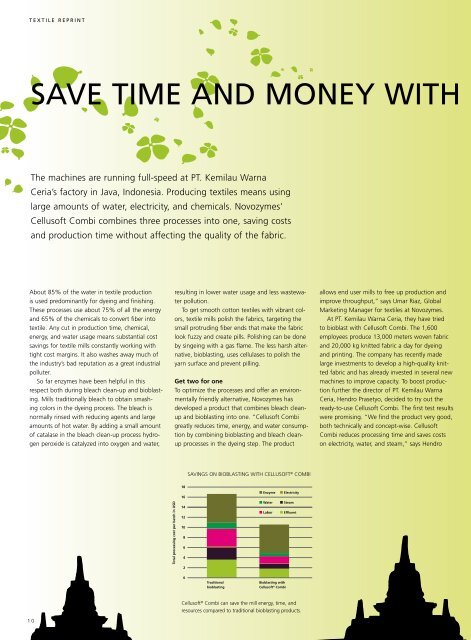

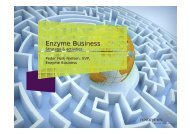


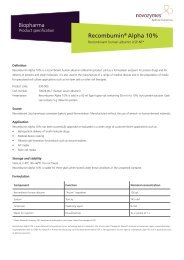
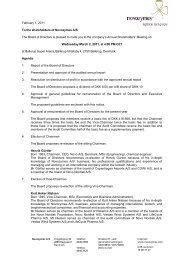

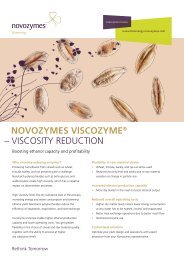

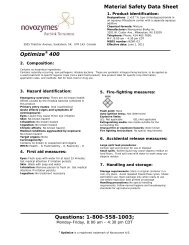

![Novozymes Cellic[®] CTec3 - Secure your plant's lowest total cost](https://img.yumpu.com/50573332/1/184x260/novozymes-cellicar-ctec3-secure-your-plants-lowest-total-cost.jpg?quality=85)
